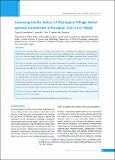Please use this identifier to cite or link to this item:
https://hdl.handle.net/20.500.14356/1730| Title: | Assessing Health Status of Khanigaun Village Development Committee in Nuwakot District of Nepal |
| Authors: | Thapa, J K Manandhar, P Subedi, R K Mahotra, N B Pandey, A |
| Citation: | ThapaJ. K., ManandharP., SubediR. K., DahalS., MahotraN. B., & PandeyA. (2016). Assessing Health Status of Khanigaun Village Development Committee in Nuwakot District of Nepal. Journal of Nepal Health Research Council. https://doi.org/10.33314/jnhrc.v0i0.719 |
| Issue Date: | 2016 |
| Publisher: | Nepal Health Research Council |
| Article Type: | Original Article |
| Keywords: | Cross-sectional study Health status |
| Series/Report no.: | Jan-April, 2016;719 |
| Abstract: | Abstract Background: Assessing health status is crucial to understand the level of health in the community. Maternal health, child health and behavioral practice on diseases are key issues to assess health status of a community in Nepal. Nationwide surveys and literature suggest that there is improvement in health status of Nepalese community. Thus, the aim of this study was to assess general health status of Khanigaun VDC of Nepal and compare it with regional and national status. Methods: A descriptive cross-sectional study was undertaken using semi-structured questionnaire, interview and observation methods. Simple random sampling was done to conduct household survey among 346 (30%) households. Ethical approval was taken from Nepal Health Research Council, Ethical Review Board Results: General Fertility Rate (GFR) of the VDC was found 69.15 per 1000 Women. Literacy rate of the VDC was 71.14% and 74.92% of households depended on agriculture for income. The major health problem of the community was diarrhea followed by unknown fever and respiratory problems. More than 50% of women breastfed their children only up to the age of one year. Contraceptive prevalence rate was 72% and more than two third of women were found to be have delivered their most recent baby at home. It was found that 31% of newborn were born underweight and measles immunization coverage was 89%. After need identification and prioritization, Micro Health Project (MHP) was conducted to create health related awareness among the people through demonstration and exhibition. Conclusions: Regular health status assessment of a community people that ultimately helps to plan the health programs and services accordingly. Keywords: Cross-sectional study; health status; khanigaun; micro health project. |
| Description: | Original Article |
| URI: | http://103.69.126.140:8080/handle/20.500.14356/1730 |
| ISSN: | Print ISSN: 1727-5482; Online ISSN: 1999-6217 |
| Appears in Collections: | Vol. 14 No. 1 Issue 32 Jan - Apr 2016 |
Files in This Item:
| File | Description | Size | Format | |
|---|---|---|---|---|
| 719-Article Text-1354-2-10-20160607.pdf | Fulltext Download | 205.83 kB | Adobe PDF |  View/Open |
Items in DSpace are protected by copyright, with all rights reserved, unless otherwise indicated.
